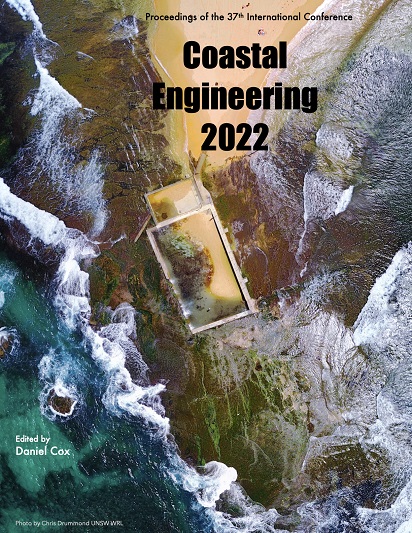Abstract
Beach topography quickly responds to the action of storm waves, resulting in foreshore erosion and accretion under calm wave conditions after a storm. Field observations were carried out on the Chigasaki coast to investigate these beach changes. It was found that the seabed shallower than 3 m depth was rapidly eroded by offshore sand transport during a storm event with the deposition of sand in a zone at depths between 3 and 5 m, and then the beach recovered within 1–2 years after the storm. Topographic changes immediately after the storm and subsequent recovery under calm wave conditions were calculated using the BG model (a model for predicting three-dimensional beach changes based on Bagnold’s concept). Given the equilibrium slope of fine sand d1 and medium-size sand d2 to be 1/120 during high waves, the erosion of the foreshore zone was numerically reproduced. Moreover, the recovery of the beach topography to a gentle slope under calm wave conditions after the storm was successfully reproduced.References
Davis Jr., R. A. and Fitzgerald, D. M. 2004. Beaches and Coasts, Blackwell Publishing, Malden, USA,
p. 419.
Fukuhama, M., Uda, T., Yamada, K., Serizawa, M., and Ishikawa, T. 2008. Model for predicting shortterm
variation of foreshore slope and shoreline applying concept of equilibrium slope, Proc. 31st
ICCE, 1839–1850.
Ishikawa, T., Uda, T., Furuike, K., Hosokawa, J., and Tako, T. 2018. Development of predictive model
of beach changes considering not only local coast but also balance in littoral cell, Proc. JSCE
(Coastal Engineering), Vol. 74, No. 2, I_883–I_888. (in Japanese)
Ishikawa, T., Uda, T., Hosokawa, J., and San-nami, T. 2020. Recovery of sandy beach after typhoon
waves–Case study on Chigasaki coast, papers.42, No. 36 vICCE.
Mase, H. 2001. Multidirectional random wave transformation model based on energy balance equation,
Coastal Eng. J., JSCE, Vol. 43(4), 317–337.
Serizawa, M., Uda, T., San-nami, T., Furuike, K., and Kumada, T. 2003. Improvement of contour line
change model in terms of stabilization mechanism of longitudinal profile, Coastal Sediments ’03,
ASCE, 1–15.
Serizawa, M., Uda, T., Suzuki, K., Maruyama, S., Takano, H., San-nami, T., and Ishikawa, T. 2009.
Numerical simulation of rapid erosion of Seisho coast triggered by storm waves during Typhoon
, Proc. Coastal Dynamics 2009, Paper No. 93, 1–14.
Uda, T., Serizawa, M., and Miyahara, S. 2018. Morphodynamic model for predicting beach changes
based on Bagnold’s concept and its applications, INTEC, London, UK, p. 188.
https://www.intechopen.com/books/morphodynamic-model-for-predicting-beach-changes-basedon-
bagnold-s-concept-and-its-applications.

This work is licensed under a Creative Commons Attribution 4.0 International License.
Copyright (c) 2023 Takahisa Tamura, Toshinori Ishikawa, Takaaki Uda, Masumi Serizawa

